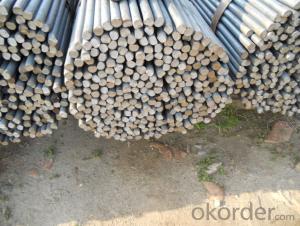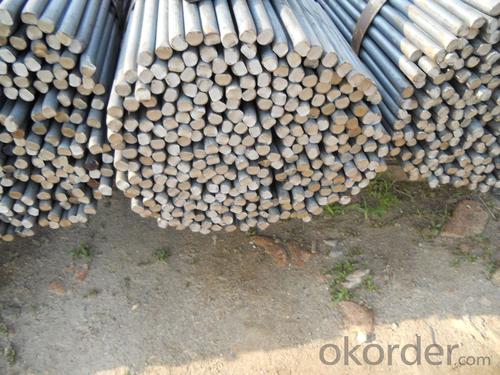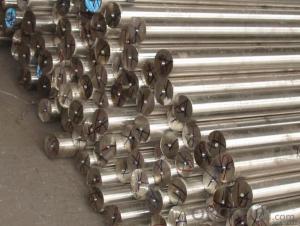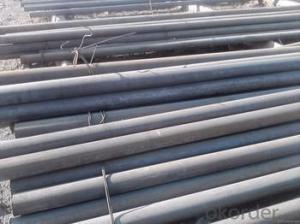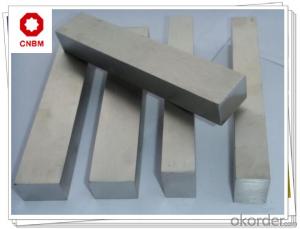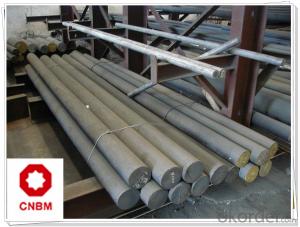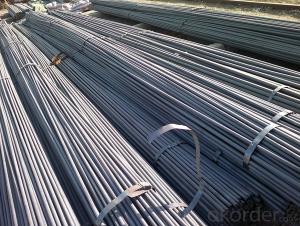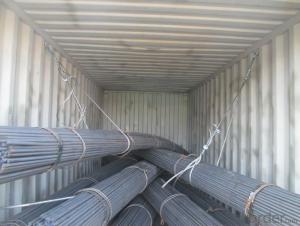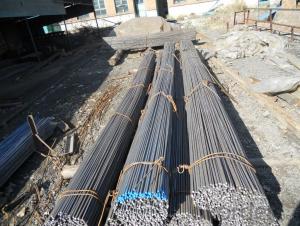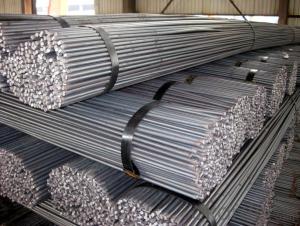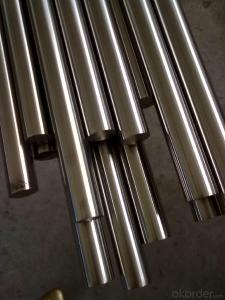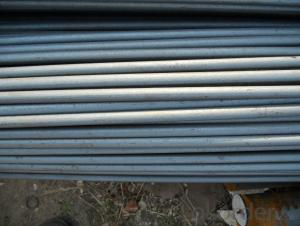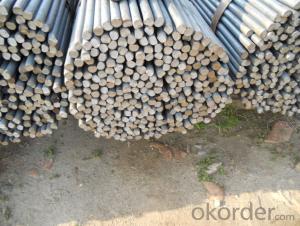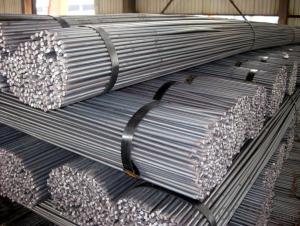Hot Rolled Steel Round Bar High Qulity Made In China JIS ASTM GB
- Loading Port:
- Tianjin
- Payment Terms:
- TT OR LC
- Min Order Qty:
- 50 m.t.
- Supply Capability:
- 20000 m.t./month
OKorder Service Pledge
OKorder Financial Service
You Might Also Like
Specification
Product Description:
OKorder is offering Hot Rolled Steel Round Bar High Qulity Made In China JIS ASTM GB at great prices with worldwide shipping. Our supplier is a world-class manufacturer of steel, with our products utilized the world over. OKorder annually supplies products to European, North American and Asian markets. We provide quotations within 24 hours of receiving an inquiry and guarantee competitive prices.
Product Applications:
Hot Rolled Steel Round Bar High Qulity Made In China JIS ASTM GB are ideal for structural applications and are widely used in the construction of buildings and bridges, and the manufacturing, petrochemical, and transportation industries.
Product Advantages:
OKorder's Hot Rolled Steel Round Bar High Qulity Made In China JIS ASTM GB are durable, strong, and resist corrosion.
Main Product Features:
· Premium quality
· Prompt delivery & seaworthy packing (30 days after receiving deposit)
· Corrosion resistance
· Can be recycled and reused
· Mill test certification
· Professional Service
· Competitive pricing
Product Specifications:
1. Material: Alloy structural steels, carbon structure steels, alloy tool and model steels,etc.
2. Process: EAF + LF + VD + Forged + Heat Treatment (optional)
3. Delivery condition:Hot forged +Rough machined (black surface after Q/T)+ Turned (optional)
4.Technical Data: Chemical Composition, Physical Properties and Mechanical Testing.
5. Test: Ultrasonic test according to SEP 1921-84 3C/c.
Chemical Composition:
C | Si | Mn | P | S | Cr | |
45Cr | 0.42-0.49 | 0.17-0.37 | 0.6-0.9 | Max0.035 | Max0.035 | 0.3 0.4 |
S45C | 0.42-0.48 | 0.15-0.35 | 0.6-0.9 | Max0.030 | Max0.035 | |
1045 | 0.43-0.5 | 0.15-0.35 | 0.6-0.9 | Max0.030 | Max0.050 |
Usage and Applications of Common Steel Round Bar
1. Common Steel Round Bar of 8-25mm, or small round is mostly used for straight bundles supply, and used for steel, bolts and various mechanical parts. While the bigger round bar, or more than 25mm hot rolled bar, is mainly for the manufacture of mechanical parts or for seamless steel billet.
2. Steel round bar is used in construction and a large number of architectural and engineering structures.
3. Besides, we can supply some especial material steel round bar that can be used for main shaft of steamer, hummer shank, with big section and supper force.
Packaging & Delivery of Common Steel Round Bar
Packaging Detail: All goods are packed in bundle with steel strips and shipped by break bulk vessel or container (depend on target market and different ports)
Delivery Detail: 45 days
Trade terms: FOB, CFR, CIF
MOQ: 25 tons per specification; we can negotiate the quantity if the specification is normal or we have stock of one specification.
Weight: The price invoicing on theoretical weight basis or actual weight basis depends on customer’s request.
Shipment: The shipment of bulk break or container is depends on customer’s request and the situation of the port of destination.
Documents given: Full set of original clean on board bill of lading; Original signed commercial invoice; Original packing list; Policy of insurance; Certificate of origin and what the target market needs.
FAQ:
Q1: Why buy Materials & Equipment from OKorder.com?
A1: All products offered byOKorder.com are carefully selected from China's most reliable manufacturing enterprises. Through its ISO certifications, OKorder.com adheres to the highest standards and a commitment to supply chain safety and customer satisfaction.
Q2: How do we guarantee the quality of our products?
A2: We have established an advanced quality management system which conducts strict quality tests at every step, from raw materials to the final product. At the same time, we provide extensive follow-up service assurances as required.
Q3: How soon can we receive the product after purchase?
A3: Within three days of placing an order, we will begin production. The specific shipping date is dependent upon international and government factors, but is typically 7 to 10 workdays.
Q4: What makes stainless steel stainless?
A4: Stainless steel must contain at least 10.5 % chromium. It is this element that reacts with the oxygen in the air to form a complex chrome-oxide surface layer that is invisible but strong enough to prevent further oxygen from "staining" (rusting) the surface. Higher levels of chromium and the addition of other alloying elements such as nickel and molybdenum enhance this surface layer and improve the corrosion resistance of the stainless material.
Q5: Can stainless steel rust?
A5: Stainless does not "rust" as you think of regular steel rusting with a red oxide on the surface that flakes off. If you see red rust it is probably due to some iron particles that have contaminated the surface of the stainless steel and it is these iron particles that are rusting. Look at the source of the rusting and see if you can remove it from the surface.
Images:
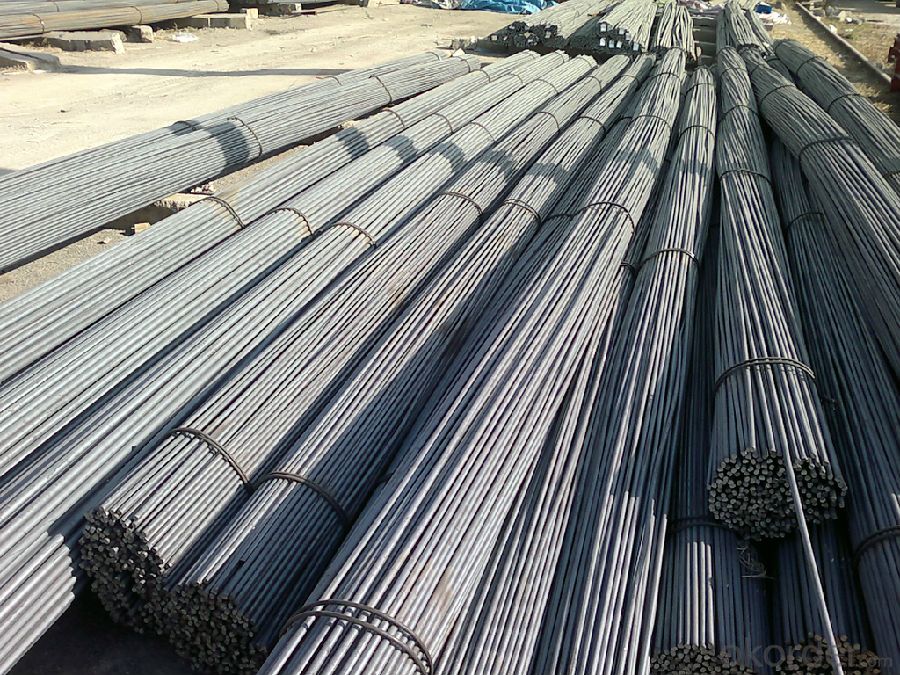
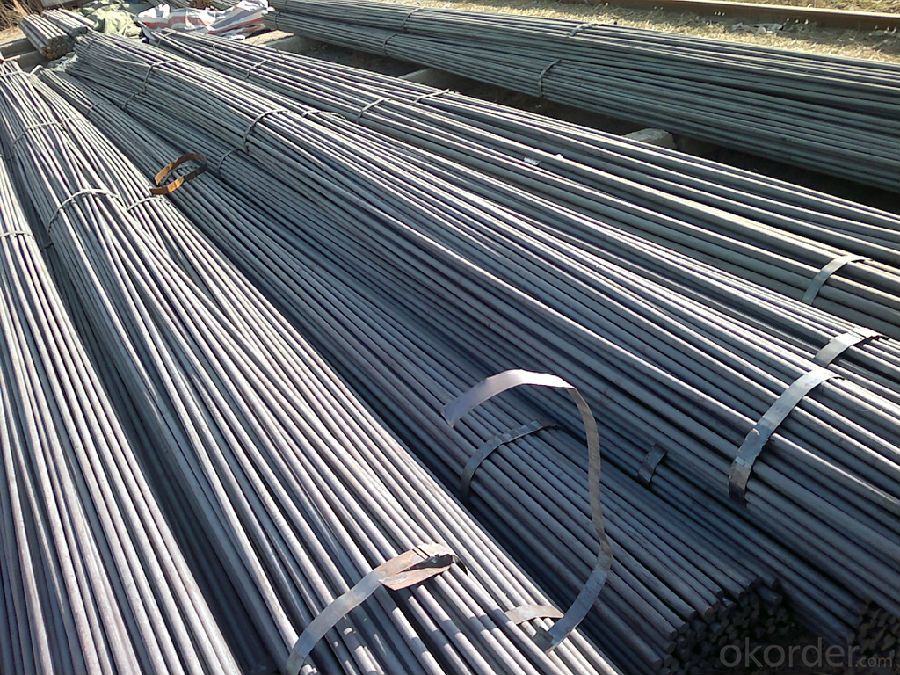
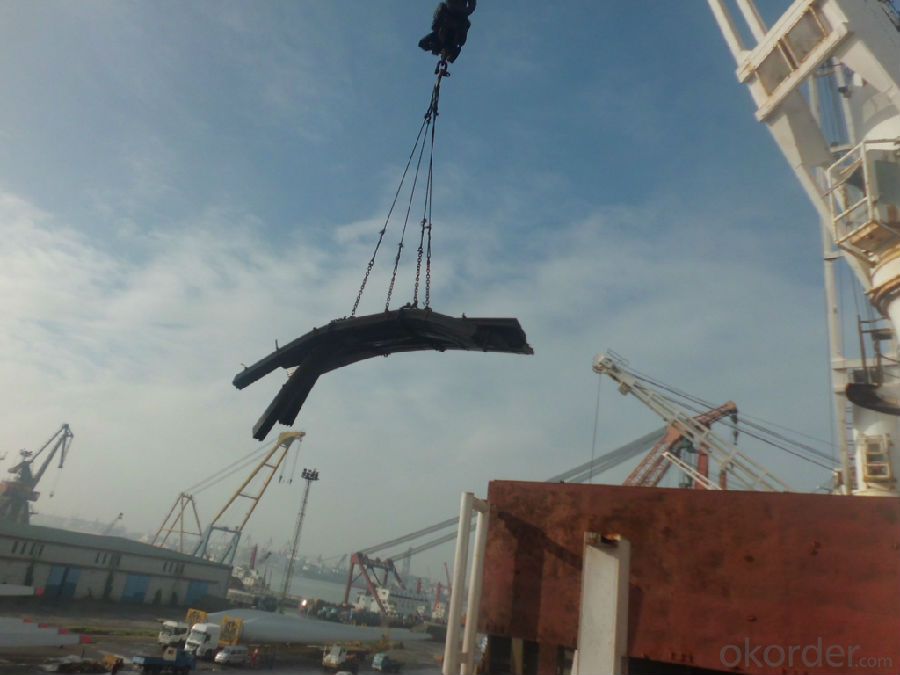
- Q: How do steel round bars compare to other materials like aluminum or stainless steel?
- Steel round bars have several advantages over other materials like aluminum or stainless steel. Firstly, steel round bars are known for their exceptional strength and durability. They have a high tensile strength, making them capable of withstanding heavy loads and extreme conditions. This makes them ideal for applications where strength and resilience are crucial, such as construction, manufacturing, and engineering. Compared to aluminum, steel round bars offer superior strength and hardness. While aluminum is lightweight, it is not as strong as steel, which can be a limiting factor in certain applications. Steel round bars also have a higher resistance to impact and abrasion, making them more suitable for heavy-duty applications that require resistance to wear and tear. In terms of comparing steel round bars to stainless steel, it's important to note that stainless steel is an alloy that contains steel as its main component. Stainless steel is known for its corrosion resistance, making it an excellent choice for applications where exposure to moisture or harsh environments is a concern. However, stainless steel does not possess the same level of strength as steel round bars. Steel round bars are capable of carrying heavier loads and providing better structural integrity. Another aspect to consider is the cost-effectiveness of steel round bars compared to aluminum or stainless steel. Steel is generally more affordable than stainless steel and aluminum, making it a popular choice for a wide range of applications. Additionally, steel round bars are readily available in various sizes and grades, offering versatility and ease of use. Overall, steel round bars excel in terms of strength, durability, and cost-effectiveness when compared to other materials like aluminum or stainless steel. However, the choice of material ultimately depends on the specific requirements of the application and the desired properties needed for the project.
- Q: How are steel round bars used in the manufacturing of heat exchangers?
- Steel round bars are commonly used in the manufacturing of heat exchangers due to their unique properties that make them suitable for this application. Heat exchangers are devices that transfer heat between two or more fluids, and steel round bars play a crucial role in their construction. One major use of steel round bars in heat exchangers is for the fabrication of the heat exchanger tubes. These tubes are responsible for carrying the fluids that need to be heated or cooled. Steel round bars are often used as the base material for these tubes due to their high strength and excellent heat transfer properties. The round shape of the bars allows for easy fabrication of the tubes, ensuring a tight and secure fit. Additionally, steel round bars are used to construct the headers and tube sheets of heat exchangers. The headers are the component that allows the fluid to enter and exit the heat exchanger, while the tube sheets hold the tubes in place. These components require high strength and durability to withstand the pressure and temperature differentials that occur during heat exchange. Steel round bars provide the necessary strength and stability to ensure the proper functioning of the heat exchanger. Furthermore, steel round bars are also used in the manufacturing of the support structures or frames of heat exchangers. These structures provide stability and support to the heat exchanger components and ensure proper alignment and positioning. Steel round bars offer excellent structural integrity and can withstand heavy loads, making them ideal for this purpose. In conclusion, steel round bars are an integral component in the manufacturing of heat exchangers. Their high strength, excellent heat transfer properties, and durability make them suitable for fabricating the tubes, headers, tube sheets, and support structures of heat exchangers. By utilizing steel round bars, manufacturers can ensure the efficiency, effectiveness, and longevity of heat exchangers in various industries, such as power generation, chemical processing, and HVAC systems.
- Q: Can steel round bars be used in the production of gears?
- Yes, steel round bars can be used in the production of gears. Steel round bars are commonly used as raw material for manufacturing gears due to their high strength, durability, and excellent mechanical properties. They can be machined, heat treated, and shaped into the desired gear profiles, making them suitable for various applications in industries such as automotive, machinery, and manufacturing.
- Q: Can steel round bars be coated with protective coatings?
- Indeed, it is possible to apply protective coatings to steel round bars. These coatings function as a shield, safeguarding the steel against corrosion, abrasion, and other forms of harm. The most prevalent form of protective coating for steel round bars is known as a corrosion-resistant coating. It is typically administered using methods such as hot-dip galvanization, electroplating, or powder coating. These coatings establish a protective layer that prevents the steel from encountering corrosive substances, moisture, and other environmental elements that may lead to deterioration. Furthermore, these coatings have the potential to enhance the aesthetic appeal of the steel round bars and extend their lifespan.
- Q: Can steel round bars be heat treated to enhance their properties?
- Yes, steel round bars can be heat treated to enhance their properties. Heat treatment processes such as quenching, tempering, and annealing can be applied to steel round bars to increase their hardness, strength, and toughness. These treatments can also improve other properties like wear resistance and machinability, making the steel bars more suitable for specific applications.
- Q: What are the different types of heat treatment for steel round bars?
- Steel round bars commonly undergo various heat treatment methods to enhance their mechanical properties and overall performance. These methods include annealing, normalizing, quenching, tempering, and case hardening. 1. Annealing: Steel round bars are heated to a specific temperature and gradually cooled to room temperature. This process reduces internal stresses, improves machinability, and enhances ductility. 2. Normalizing: The steel round bars are heated above the critical range and cooled in still air. Normalizing refines the grain structure and improves mechanical properties like strength and toughness. 3. Quenching: Steel round bars are heated to a high temperature and rapidly cooled by immersing them in a quenching medium such as water, oil, or polymer. This results in a hardened microstructure, increasing hardness and wear resistance. 4. Tempering: After quenching, the steel round bars undergo tempering. The quenched steel is reheated to a specific temperature and cooled in still air. Tempering reduces brittleness caused by quenching, increases toughness, and relieves residual stresses. 5. Case hardening: This process increases the hardness and wear resistance of the outer surface of steel round bars while maintaining a tough and ductile core. Case hardening involves heating the steel in a carbon-rich atmosphere or applying a carbon-rich substance, followed by quenching and tempering. Each heat treatment method has its advantages and is chosen based on the desired properties and applications of the steel round bars. It is crucial to select the appropriate heat treatment process to achieve the desired mechanical properties and performance.
- Q: Can steel round bars be used in the manufacturing of machinery?
- Certainly, machinery manufacturing can make effective use of steel round bars. Various industries commonly employ steel round bars due to their robustness, longevity, and adaptability. These bars frequently serve in the fabrication of essential components like shafts, axles, gears, and other mechanical parts that necessitate exceptional strength and resistance against deterioration. Notably, steel round bars exhibit remarkable mechanical properties, encompassing impressive tensile strength and superior machinability, rendering them highly suitable for heavy-duty machinery and equipment. Furthermore, steel round bars can be conveniently welded, forged, or machined into the desired configuration, thus establishing them as a preferred option for machinery manufacturing.
- Q: Are steel round bars suitable for the production of hydraulic cylinders?
- Yes, steel round bars are suitable for the production of hydraulic cylinders. Steel is a material known for its strength, durability, and resistance to corrosion, making it an excellent choice for hydraulic applications. Steel round bars are often used in the construction of hydraulic cylinders due to their high tensile strength and ability to withstand heavy loads and pressure. Additionally, steel can be easily machined and welded, allowing for precise manufacturing and customization of hydraulic cylinders. Overall, steel round bars provide the necessary qualities and performance required for the production of hydraulic cylinders.
- Q: What is the hardness of a steel round bar?
- The hardness of a steel round bar can vary depending on the specific type of steel and the manufacturing process used. Steel is typically measured for hardness using the Rockwell hardness scale, which measures the depth of indentation caused by a specific load on a diamond or steel ball. Common hardness values for steel round bars can range from around 20 to 60 Rockwell C (HRC), with higher numbers indicating a harder material. However, it is important to note that the hardness of a steel round bar can also be influenced by factors such as heat treatment, alloying elements, and any surface treatments applied. Therefore, it is essential to consult the specific hardness specifications provided by the manufacturer or supplier to accurately determine the hardness of a steel round bar.
- Q: What are the different alloying elements used in steel round bars?
- There are several alloying elements that can be used in the production of steel round bars. These elements are added to enhance the properties of the steel and improve its strength, durability, and other specific characteristics. Some of the commonly used alloying elements in steel round bars include: 1. Carbon: Carbon is the primary alloying element in steel and helps to increase its hardness and strength. The carbon content in steel round bars usually ranges from 0.2% to 2.1%. 2. Chromium: Chromium is added to steel to improve its resistance to corrosion and oxidation. It also enhances the steel's hardness, strength, and wear resistance. Stainless steel round bars often contain chromium as a major alloying element. 3. Nickel: Nickel is commonly used in stainless steel round bars to improve their corrosion resistance and enhance their mechanical properties. It also increases the toughness and strength of the steel. 4. Manganese: Manganese is added to steel to improve its hardenability, strength, and wear resistance. It also contributes to the steel's ability to withstand impact and shock loading. 5. Molybdenum: Molybdenum is often used in steel round bars to enhance their strength, toughness, and resistance to corrosion. It also improves the steel's high-temperature strength and creep resistance. 6. Vanadium: Vanadium is added to steel to improve its strength, toughness, and wear resistance. It also helps in refining the steel's grain structure, which enhances its mechanical properties. 7. Tungsten: Tungsten is used in steel round bars to increase their hardness, strength, and resistance to wear and corrosion. It also improves the steel's high-temperature strength and toughness. 8. Silicon: Silicon is added to steel to improve its strength, hardness, and resistance to oxidation. It also helps in deoxidizing the steel during the manufacturing process. 9. Copper: Copper is sometimes used as an alloying element in steel to improve its corrosion resistance, thermal conductivity, and electrical conductivity. These are just some of the alloying elements that can be used in steel round bars. The specific combination and proportion of these elements depend on the desired properties of the steel and the intended application of the round bars.
Send your message to us
Hot Rolled Steel Round Bar High Qulity Made In China JIS ASTM GB
- Loading Port:
- Tianjin
- Payment Terms:
- TT OR LC
- Min Order Qty:
- 50 m.t.
- Supply Capability:
- 20000 m.t./month
OKorder Service Pledge
OKorder Financial Service
Similar products
Hot products
Hot Searches
Related keywords
